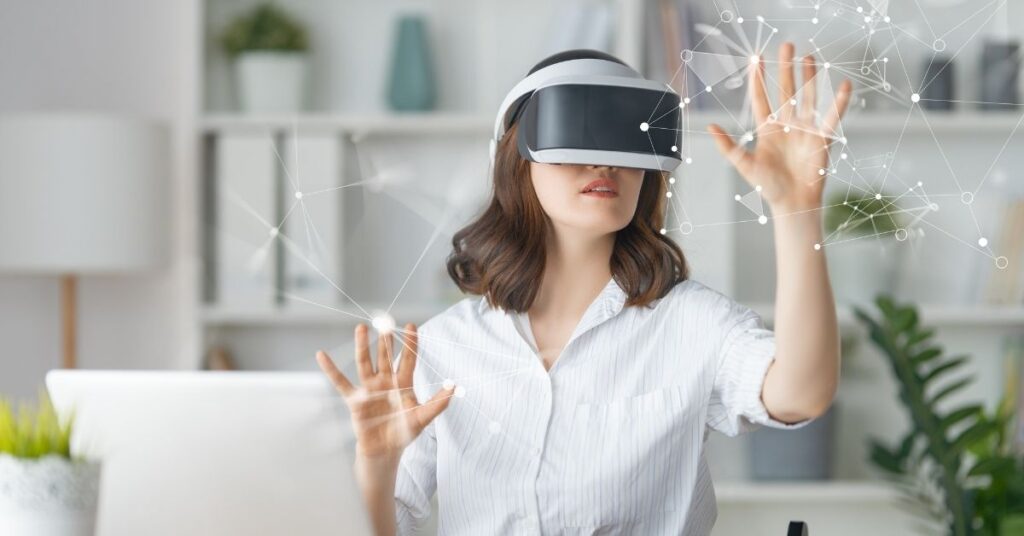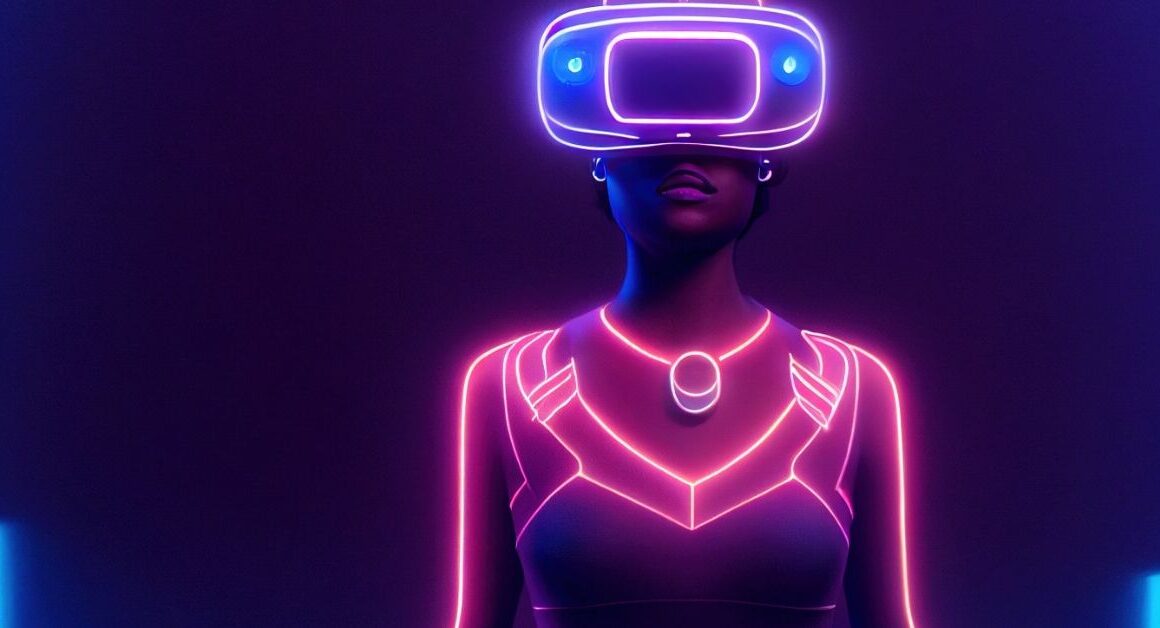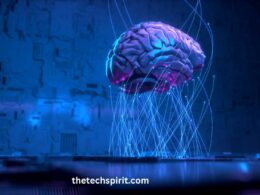Virtual reality and artificial intelligence (AI) represent two of the most transformative technologies of the 21st century. Though their current applications may seem limited to niche industries, these technologies hold immense potential to reshape society when combined synergistically.
VR utilizes hardware like headsets and haptic gloves to generate simulated 3D environments that users can interact with. This creates an immersive experience that transports users to digitally created worlds.
On the other hand, Artificial Intelligence refers to machine intelligence capable of performing tasks that typically require human cognition. From natural language processing to computer vision, AI algorithms can analyze data and make decisions or predictions.
Though Virtual Reality and Artificial Intelligence started developing separately decades ago, they are increasingly intersecting and complementing each other today. Let’s look at some of their key applications and future possibilities when used together.
Table of Contents
Current Applications of Virtual Reality and Artificial Intelligence
Gaming and Entertainment
Gaming represents one of the most popular uses of consumer VR technology today. AI algorithms can generate interactive Virtual Reality environments and non-player characters (NPCs).
For example, Artificial Intelligence NPC enemies in Virtual Reality games can realistically respond to players’ behaviors by making contextual decisions.
Artificial Intelligence also enables Virtual Reality characters to hold natural conversations using speech recognition and natural language processing. This makes interactions more immersive. Generative AI can even create entire Virtual Reality worlds procedurally instead of developing content manually.
Training and Simulation
Virtual Reality creates safe virtual environments for training scenarios that are too dangerous, expensive, or impractical to replicate in the real world.

For instance, Virtual Reality simulations allow surgeons to develop skills without endangering real patients. AI makes these simulations more useful by analyzing trainee behaviors to provide personalized feedback.
Virtual Reality training with intelligent simulation adjustments can accelerate skill development. Areas like pilot training and military drills rely heavily on Virtual Reality training systems with embedded AI.
Healthcare
Virtual Reality is being used in healthcare to treat phobias and anxiety disorders by immersing patients in simulations of experiences like public speaking or heights. AI tailors these VR therapy scenarios by tracking bio-signals like heart rate.
Virtual Reality also assists in pain management and physical therapy by creating engaging treatments.
Artificial Intelligence powers the creation of 3D simulations from medical scan data that surgeons can interact with in Virtual Reality for pre-operative planning. This allows them to gain a better understanding of patient anatomy before complex procedures.
Education
Virtual Reality enables students to engage with digital recreations of anything from historical landmarks to molecular models.
AI assistants within these VR learning environments can answer student questions using natural language processing. Artificial Intelligence tutors also adapt lessons based on individual learning patterns.
Immersive Virtual Reality field trips augment traditional teaching methods. Students retain information better when they can interact with educational environments instead of passively viewing content.
Intelligent Virtual Reality tutors reduce the demands on human teachers while enabling personalized instruction.
The Synergy Between Virtual Reality and Artificial Intelligence
AI Enhancing Virtual Reality Experiences
Many exciting Virtual Reality experiences depend on Artificial Intelligence technologies to function. As mentioned earlier, natural language processing allows users to converse with virtual characters.

Similarly, computer vision tracks user movements to translate them into VR environments. Generative AI creates expansive worlds, characters, and narratives for unlimited VR content.
Artificial Intelligence makes Virtual Reality interactions smoother, and more natural and reduces the need for manual content creation. It enables key Virtual Reality capabilities like responsive NPCs and adaptive simulations. Artificial Intelligence will continue to enhance Virtual Reality as the supporting technologies progress.
Virtual Reality for Training AI Algorithms
On the flip side, Virtual Reality also provides value in training AI algorithms. Real-world data needed to train AIs is often scarce and skewed. Virtual Reality generates abundant synthetic data for training under whatever conditions developers want.
For example, autonomous vehicles are trained extensively in Virtual Reality simulated environments before being tested on real roads. VR spaces allow reinforcement learning of pedestrian avoidance behaviors without any real risk. This data also supplements real-world driving data to improve training efficiency.
As Virtual Reality datasets get larger and more photorealistic, they will become even more useful for training robust AI models.
In the future, most AI agents might learn initially in virtual environments rather than the physical world.
Future Possibilities for Virtual Reality and AI
More Immersive Virtual Worlds
With more advanced hardware and intelligent interfaces, Virtual Reality will become much more immersive in the next 5-10 years.

We’ll have photorealistic visuals, directional 3D audio, and haptic feedback for touch. AI will enable natural interactions using multi-modal inputs like eye tracking, face/gesture recognition, and speech.
Mass adoption will drive rapid enhancements in realism, ergonomics, and wireless capabilities. We may see widespread use of Virtual Reality in fields like design, medicine, communication, and data visualization where immersion is highly valuable.
Virtual Reality for Social Connection
Current social Virtual Reality spaces are limited to cartoonish avatars and environments. As fidelity increases, Virtual Reality will become a popular social platform. AI assistants can facilitate interactions and ensure safety/comfort in these spaces.
Virtual Reality can bridge geographical distances and supplement real-life relationships. Virtual Reality lets people completely customize how they appear, removing physical appearance biases.
AI moderation will prevent harassment by muting/blocking rule-breaking users automatically. The social implications of shared virtual worlds go beyond today’s social media.
Revolutionizing Business Operations
Virtual Reality productivity tools will enable remote collaboration that feels more natural and immersive. Complex 3D data will become instantly accessible in virtual workspaces. Hands-free interactions via eye tracking and speech make workflows more efficient.
Artificial Intelligence helps manage programs and data seamlessly in the background. It provides multi-modal natural interfaces between users and software.
Real-time language translation enables global teams to collaborate in Virtual Reality. Virtual Reality office spaces may completely replace video conferencing for remote meetings.
New Methods of Creativity and Design
Virtual Reality unlocks unprecedented levels of immersion for creators. Artists can apply 3D inputs directly in space instead of 2D surfaces.
Architectural/industrial design happens faster by letting people inhabit VR prototypes before manufacturing. AI assists by suggesting creative variations.
Immersive ideation in Virtual Reality with Artificial Intelligence support removes creative limitations tied to the physical world. Anything imaginable can be prototyped. All fields from performing arts to engineering will use Virtual Reality as a blank creative canvas. Exciting new art and design methods are on the horizon.
Challenges for Widespread Adoption of VR and AI
Hardware Limitations
The hardware capabilities needed for fully immersive consumer Virtual Reality still appear to be some years away. Computing power, display resolution/field-of-view, wireless bandwidth, and battery capacities need significant improvements.
More R&D is also needed for multi-sensory haptic feedback beyond basic vibration. As a result, current headsets remain bulky and uncomfortable for long-term use.
Tech giants continue investing heavily in developing better Virtual Reality hardware.
Computing platforms like the Metaverse are also set to accelerate hardware progress.
Health Concerns
The long-term health impacts of Virtual Reality usage remain relatively unknown. Extensive use could negatively affect eye development in younger children. Prolonged immersion may also cause visual disorders, nausea, dizziness, and other issues. More research is needed to enact evidence-based hardware safety guidelines.
Additional aspects requiring regulation include maximum screen time limits, age-appropriate content, and nominal headset configurations.
Policy frameworks will likely evolve gradually as Virtual Reality usage increases. Responsible development is critical to building trust and acceptance.
Privacy and Ethical Issues
Like many emerging technologies, VR and AI present potential risks if misused. Virtual Reality experiences rely heavily on biometric data which raises privacy concerns around surveillance and data exploitation. The data needed to train AI models can perpetuate biases if not curated ethically.
Powerful generative AI like Virtual Reality world generators may cause copyright/IP issues and dissent from creative professionals as the tech matures. Wise governance, ethics review boards, and public discourse are critical to developing these technologies responsibly.
Conclusion
Virtual Reality and Artificial Intelligence are complementary technologies poised to transform humanity’s relationship with information, creativity, communication, and reality itself. Though some challenges exist, responsible innovation can unlock immense possibilities in the coming decades.
Collaboration between policymakers, researchers, and tech companies will determine how rapidly these exponential technologies benefit society. But the opportunities for human progress and flourishing are truly boundless.
FAQs
What are some current limitations of VR technology?
Some current limitations of VR technology include limited display resolution resulting in screen-door effects, limited field of view, bulky headset designs, lack of mobility due to wired connections, computing constraints for complex graphics rendering, difficulty in simulating haptics for touch sensations, and ergonomic issues from prolonged use.
How are Big Tech companies using VR and AI?
Big tech companies are using VR and AI in a variety of ways. Meta (formerly Facebook) has invested heavily in VR headsets, aiming to bring VR social experiences mainstream.
Google incorporates VR and AI in applications like cloud-based 3D model rendering, while Apple uses AR for consumer features. Microsoft develops enterprise VR applications, and Amazon utilizes AI-driven recommendations to improve VR experiences.
What are the concerns around data privacy with VR and AI?
As VR depends on collecting user data like movement, inputs, and biometric data to deliver experiences seamlessly, it raises huge privacy concerns around surveillance.
AI algorithms being trained on user data may perpetuate biases if the data is not properly curated from diverse sources. There is a need for regulation around data collection transparency, consent, use restrictions, and preventing personally identifiable data exploitation.
How can VR and AI improve education?
VR can make learning highly engaging by letting students experience simulations first-hand for deeper understanding. AI tutors provide personalized support, grade assignments, and adapt to student needs automatically.
Immersive VR class trips are safer and cheaper than real trips. VR and AI together can make education accessible to all by removing geographical and economic barriers.
What are some ways VR can be used for creativity?
VR enables entirely new creative workflows. Artists can paint and sculpt in 3D space instead of 2D. Architects can inhabit building designs before construction.
Filmmakers can storyboard scenes by arranging settings/characters simulated in VR. Musicians can craft 3D audio environments for new compositions. Fashion designers can prototype clothing virtually. VR provides limitless digital clay for every creative field.









